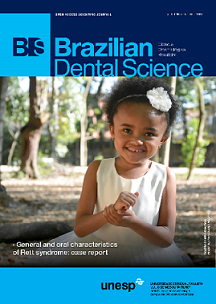Anticoagulant-induced oral bleeding
DOI:
https://doi.org/10.14295/bds.2017.v20i3.1379Resumo
Warfarin is an anticoagulant used to prevent thrombosis, cardiac arrhythmias, atrial fibrillation, and recurrence of pulmonary embolism. A 69-year-old male patient reported episodes of four heart attacks, stroke, pulmonary emphysema, varicose veins, thyroid dysfunction, and a history of angioplasty. They use daily dose of 5 mg. Intraoral clinical examination revealed a bleeding nodular lesion of purple color with irregular borders and a smooth surface. The prothrombin time was 68.9 seconds, activity was 10%, and the international normalized ratio (INR) was 8.26. Based on these results, the patient received a single dose of 2.5 mg vitamin K via subcutaneous route. The final diagnosis was oral anticoagulant-induced lesions. Clinicians should be familiar with the side effects of anticoagulants, which are rare in the oral cavity, but can be life-threatening if diagnosed late or inaccurately, especially in older patients that often use many drugs.
Keywords
Anticoagulant; Hemorrhage; Warfarin; Mouth.
Downloads
Downloads
Arquivos adicionais
Publicado
Como Citar
Edição
Seção
Licença
TRANSFERÊNCIA DE DIREITOS AUTORAIS E DECLARAÇÃO DE RESPONSABILIDADE
Toda a propriedade de direitos autorais do artigo "____________________________________________________________________" é transferido do autor(es) para a CIÊNCIA ODONTOLÓGICA BRASILEIRA, no caso do trabalho ser publicado. O artigo não foi publicado em outro lugar e não foi submetido simultaneamente para publicação em outra revista.
Vimos por meio deste, atestar que trabalho é original e não apresenta dados manipulados, fraude ou plágio. Fizemos contribuição científica significativa para o estudo e estamos cientes dos dados apresentados e de acordo com a versão final do artigo. Assumimos total responsabilidade pelos aspectos éticos do estudo.
Este texto deve ser impresso e assinado por todos os autores. A versão digitalizada deverá ser apresentada como arquivo suplementar durante o processo de submissão.




























